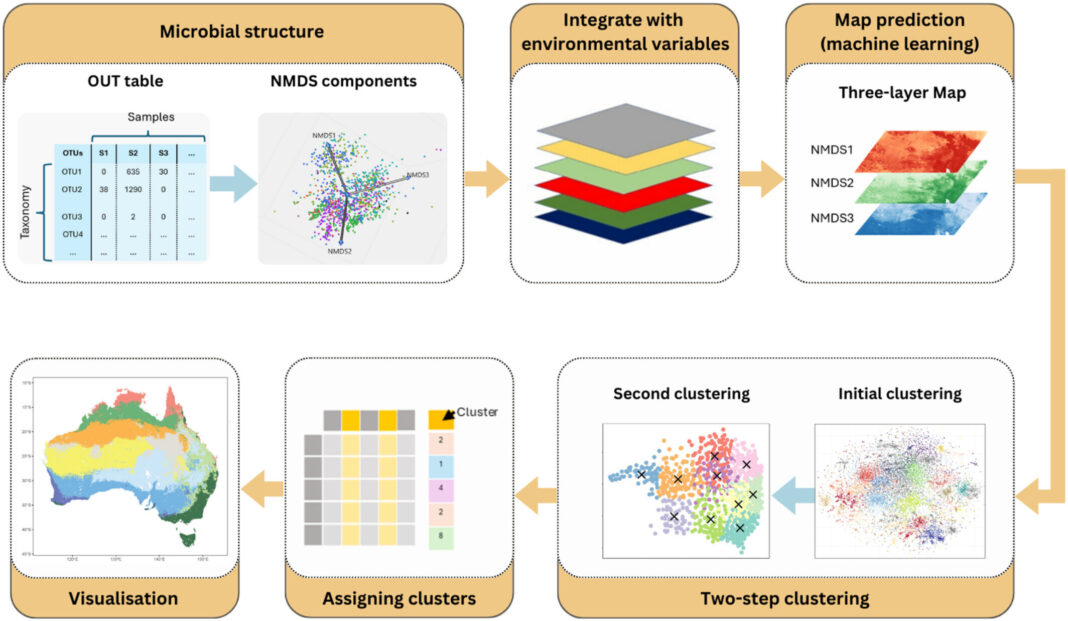Researchers from the Sydney Institute of Agriculture at the University of Sydney investigated the vast and largely hidden world beneath our feet. Soil is where 59% of all life on Earth resides.
A single gram of soil can contain up to 10 billion bacteria, far exceeding the human population on the planet. Like plants and animals, these soil microorganisms have habitat preferences. Given Australia’s diverse landscapes, soils, and climates, the researchers sought to determine whether soil microbes occupy specific habitats shaped by their surrounding environment.
In the study, published in Global Change Biology, the team analyzed environmental DNA (eDNA) from soil samples collected across the Australian continent. The study revealed that bacterial and fungal communities are influenced by different environmental drivers.
Soil pH emerged as the dominant factor shaping bacterial diversity, while fungal communities were more strongly influenced by climatic variables, particularly rainfall and temperature fluctuations.
Leveraging artificial intelligence (AI) models, the researchers predicted the geographic distribution of various microbial groups across Australia. The resulting bacterial distribution mirrored the country’s soil types map, whereas fungal distributions aligned more closely with climatic zones and vegetation patterns.
These findings suggest that fungal communities are more sensitive to broader environmental conditions beyond soil characteristics alone.
The researchers extended their analysis by incorporating climate projections to assess potential changes by the year 2040. The models indicated that both bacterial and fungal communities are likely to shift southward in response to increasing temperatures, with the most pronounced changes occurring near the 25°S latitude.
However, the extent of these shifts differs between the two groups. Approximately 24% of Australia’s land area is projected to experience significant changes in fungal community composition, while bacterial communities are expected to shift across approximately 19% of the landscape. Such alterations in microbial distribution could have substantial consequences for soil function, given the central role these organisms play in carbon and nutrient cycling.
The researchers attribute these differences to the distinct biological characteristics of bacteria and fungi. Bacteria, being highly diverse, fast-growing, and metabolically adaptable, are more strongly governed by soil properties and capable of thriving across a broad range of conditions.
In contrast, fungi are more dependent on stable moisture and temperature regimes, rendering them more susceptible to the impacts of climate change.
For land managers and farmers, this means we need targeted strategies. To support bacteria, focus on improving soil conditions—especially pH. For fungi, consider broader, climate-adapted solutions like planting cover crops that help retain soil moisture and buffer heat stress.
Understanding where soil microbes live—and why—has never been more important as the climate changes. These microscopic communities underpin soil security, food security, and even climate regulation. Mapping their invisible world is the first step toward managing it wisely.
More information:
Peipei Xue et al, The Biogeography of Soil Bacteria in Australia Exhibits Greater Resistance to Climate Change Than Fungi, Global Change Biology (2025). DOI: 10.1111/gcb.70268
Provided by
University of Sydney
Citation:
Fantastic soil microbes and where to find them (2025, June 10)
retrieved 10 June 2025
from https://phys.org/news/2025-06-fantastic-soil-microbes.html
This document is subject to copyright. Apart from any fair dealing for the purpose of private study or research, no
part may be reproduced without the written permission. The content is provided for information purposes only.





